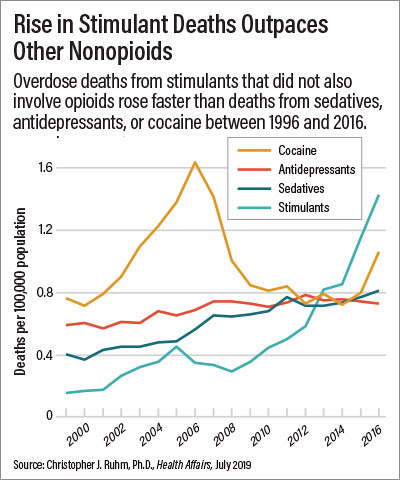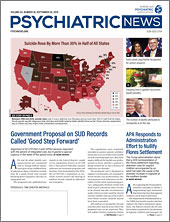Overdose deaths involving nonopioids such as cocaine or stimulants rose almost as quickly as those involving opioids, a study in Health Affairs has found. An analysis of the death certificates of roughly 45 million U.S. residents revealed that overdose deaths involving nonopioids rose 274% between 1999 and 2016, compared with a 371% increase in opioid overdose deaths during this timeframe. Although most of the deaths that involved nonopioids also involved opioids, the number of deaths attributable to nonopioids alone rose 122%.
“I’ve been looking at drug deaths for a number of years, before there was so much attention to opioids, and I noticed broader patterns. I suspected there was going to be more of a nonopioid problem than was getting attention, but I was struck by the degree to which that was the case,” said study author Christopher J. Ruhm, Ph.D., a professor of public policy and economics at the Frank Batten School of Leadership and Public Policy at the University of Virginia.
Ruhm found that 91% of the nonopioid deaths involved four categories of drugs: stimulants, antidepressants, sedatives, and cocaine. Although death rates increased in all four categories, the greatest increase occurred in deaths involving stimulants: Those that did not also involve opioids jumped more than 816%, whereas deaths from combining stimulants with opioids soared more than 1,016%.
Much of the increase in stimulant deaths occurred in a two-year surge between 2014 and 2016, a trend that shows no signs of slowing. In the May 3 Morbidity and Mortality Weekly Report, a study by researchers at the CDC’s National Center for Injury Prevention and Control revealed that deaths involving stimulants jumped 37% from 2016 to 2017.
The drivers behind the increase in stimulant deaths are largely unknown, Ruhm told Psychiatric News.
“One of the obvious questions would be how much of this is related to illicit versus legal stimulants. My sense is this is more an issue of illicit stimulants, but I haven’t seen a lot of good research on that,” Ruhm said. “I also wonder about the [misuse] of prescribed stimulants. It’s not uncommon for college students to take them for an all-nighter.”
Although the sedative death rate climbed at a slower pace than the stimulant death rate, sedatives were involved in the greatest number of nonopioid overdose deaths overall. Most of those deaths involved benzodiazepines, usually in combination with opioids. Likewise, cocaine deaths, after declining for several years, began a sharp ascent in 2015, a phenomenon Ruhm attributes to lacing cocaine with fentanyl. Deaths from antidepressants began to decline in 2013.
In his analysis, Ruhm noted a limitation to the findings in that when both opioids and nonopioids are involved in a death, it is usually not possible to assign a primary role in the death to one or the other. This speaks to the need for an all-encompassing approach to curtailing drug misuse and abuse, Ruhm told Psychiatric News.
“I don’t think it’s possible to focus too much attention on opioids. It’s a horrendous problem we need to pay attention to, but we need to be able to look at more than one thing at once,” Ruhm said.
This study was supported by the University of Virginia’s Bankard Fund. ■
“Nonopioid Overdose Death Rates Rose Almost As Fast As Those Involving Opioids, 1999-2016” is posted
here. “Drug Overdose Deaths Involving Cocaine and Psychostimulants With Abuse Potential—United States, 2003-2017” is posted
here.


